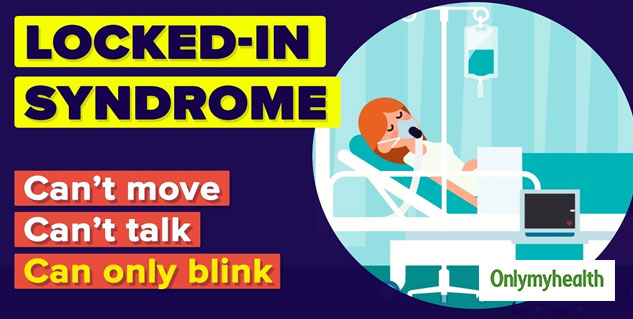
What is Locked-In Syndrome(LIS)? Locked-in syndrome is when the patient cannot communicate to you and is wholly paralyzed of both hands and both legs. The patient will not be able to move hands and legs, but the patient will be aware of the surroundings but will be bed bound. Pseudocoma is also known as a condition in which the person cannot control their hands and legs because of damage to their upper brain stem or bilateral thalamus. The patient will only be able to move their eyes and not any other body part. This is known as locked-in syndrome. She/he can see and then try to communicate with others. Conscious but voiceless and paralyzed: Acute brainstem lesions is the most common cause of LIS. This is that portion of the brain that acts as a bridge between the brain and body. Other rarer causes are trauma, tumours or infections.
Table of Content:-
What are the symptoms of the locked-in syndrome(LIS)?
Usually, the patient will have weakness of all the four limbs, or the term is called Quadriplegia where the patient will not be able to lift her/his hands and won’t be able to move his legs. So the patient can only communicate through eye movements, and the patient will be paralysed entirely – both upper and lower limbs. A coma-like condition where the subject only can share or respond with others by eye movements. Affected individuals are utterly reliant on caregivers and bedridden. Cognitive function is unaffected despite physical paralysis. Individuals with locked-in syndrome are aware and vigilant of their environment. They can see, hear and have protected sleep-wake cycles.
Also read: What is Carpal Tunnel Syndrome
What are the causes behind the locked-in syndrome(LIS)?
The most common causes we see is due to stroke; what we call a paralysis. This is a disease where there is a clot in the blood vessel that causes the damage to a brain structure called the brainstem. There is a clot which is a blockage of the vessel that causes damage to the brainstem, and then it leads to locked-in syndrome. Another cause is trauma. For example, if the patient had a severe head injury or brain infection, they can also go into a locked-in syndrome. The other reason may be toxic, and if the patient has consumed a lot of poison or drugs in the high dose, this can result in locked-in syndrome.

What is the prognosis of the locked-in syndrome(LIS)?
Prognosis is very guarded and depends upon the cause. For example, if it is due to poisoning or drug intoxication, we can remove this from the blood, clean it up, and improve the condition. If the patient has had a stroke and is brought immediately, we can break open the clot and what we call thrombolysis, and the state of the patient improves. But once the patient is already had a complete locked-in syndrome, the prognosis is not good. This is because they are bedridden for the long term and are prone to other complications like bed sore, aspiration pneumonia and deep vein thrombosis.
Also read: What Is Wrist Sprain? Here Are Its Symptoms, Causes, Treatment And Prevention Tips
Risk factors: Who is at risk of developing locked-in syndrome (LIS)?
Patients who have risk factors of stroke, like uncontrolled diabetes mellitus, uncontrolled hypertension, smokers, alcoholics, obese people, oversleep, rampant high cholesterol patients with an underlying cardiac condition, are at higher risk of developing the stroke. They can create a brainstem stroke resulting in locked-in syndrome. And patients who have had repeated brain and head injuries can also suffer from a locked-in syndrome. Patients who take drugs and other banned substances, they can result in having a locked-in syndrome.

What are the treatment choices available for the locked-in syndrome(LIS)?
- Treatment depends upon the cause. For example, for the patients who had a stroke with brainstem involvement, the treatment is excellent and complete recovery is possible if they come within what we call a window period. If it is a stroke, you give antiplatelets, blood thinners, and try to revive the brain through certain neurotics and physiotherapy. If the victim comes to the clinic within three hours of the stroke, we can break open that clot using a new injection and the patient can be treated.
Also read: Ways to ease the pain of carpal tunnel syndrome
- In case the patient had poison, the stomach has to be cleaned first, poisoning has to be removed, and since poisoning has already entered the blood, we need to give an antagonistic drug to the patient. A medication, tablet or injection has to be shown since it acts opposite to the poisoning.
- In case of traumatic brain injury, like if the patient had a head injury, it depends on the degree of brain damage and has to be treated accordingly.
Here Are Some FAQs related to locked-in syndrome(LIS)

- Prevention Tips: How to prevent locked-in syndrome(LIS)? Be fit; make sure you take care of all the stroke risk factors not to happen. And in case the patient develops any of the symptoms rush immediately to the nearby hospital so that as early you treat stroke, the poisoning or traumatic brain injury, the better is the prognosis. You can prevent it by managing hypertension, blood pressure, sugar, eating food on time, eating fruits and vegetables, low cholesterol diet, exercising.
- Locked-In Syndrome (LIS): When should one seek medical advice? Seek medical advice immediately (as soon as possible). It is recommended that whenever the patient has the symptoms, make sure to rush them to a hospital where the facilities are available. In the case of a stroke or a head injury or poisoning, the earlier you present to the hospital, the better the outcome.
- What symptoms indicate a complication of the locked-in syndrome (LIS)? Chest paining, swelling in the legs, chest pain, cough are signs that complications are underway. The patient becomes very drowsy, pooling in the lungs causing pneumonia, bed sores or develops deep vein thrombosis in the legs; these are all the locked-in syndrome complications.
Also Read: Sleep Apnea In Diabetics May Cause Blindness
- Can a person recover from locked-in syndrome? Locked-in syndrome (LIS) or pseudocoma affects around one per cent of people who have a stroke. It is a disease for which there is no cure or treatment, and it is rare for patients to recover any significant motor functions. About ninety per cent die within four months of its onset.
- What is the expected duration of the locked-in syndrome (LIS)? Duration of the locked-in syndrome depends upon the cause. It might take months, years or even a second. they may also recover within a few days to a week. Patients with a head injury and traumatic brain injury may take a few weeks or two months to recover.

- Can you feel pain with locked-in syndrome(LIS)? You can feel hunger, pain, fear, and loneliness, but you cannot react to those sensations. You are aware of your surroundings, but you cannot communicate your desires or feelings, or even your basic needs. The term for this horror is a locked-in syndrome or pseudocoma.
- How long can you live with locked-in syndrome (LIS)? The life expectancies of stable locked-in syndrome (LIS) patients may be very long; eighty-three per cent of patients live ten years, and forty per cent live twenty years. The result of the “quality” of this life also remains a significant hurdle.
(With inputs from Dr Anil Ramakrishna, Head of Neurology, Columbia Asia Hospital Hebbal)
Read more articles on Other diseases
Also watch this video
How we keep this article up to date:
We work with experts and keep a close eye on the latest in health and wellness. Whenever there is a new research or helpful information, we update our articles with accurate and useful advice.
Current Version
